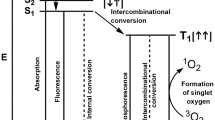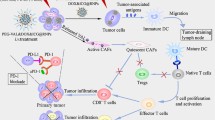Abstract
Destruction of the neovasculature is essential for efficient tumor eradication by photodynamic therapy ( PDT). The PDT anti-vascular effect can be promoted by developing addressed photosensitizers localized preferentially to the tumor vascular compartment. A new photosensitizer conjugated to an heptapeptide [ H-Ala-Thr-Trp-Leu-Pro-Pro-Arg-OH ( ATWLPPR)] targeting neuropilin-1, a Vascular Endothelial Growth Factor (VEGF) co-receptor, has been synthesized. It was administered intravenously for an easier access to endothelial cells lining the vasculature in human malignant glioma-bearing nude mice. Plasma pharmacokinetic parameters were derived from plasma concentration—time data using a non-compartmental analysis and validated a relatively rapid elimination from the blood compartment with an elimination rate constant of 0.062 h−1 and a biological half-life of 11.0 h. The photosensitizer was mainly concentrated in organs such as liver, spleen and kidneys, which are rich in reticuloendothelial cells. In these organs, the elimination profiles of the photosensitizer were comparable, with half-lives as short as 12.2, 15.1 and 19.7 h, respectively. The peptidic moiety of the conjugated photosensitizer was degraded to various rates depending on the organ considered, most of the degradation process occurred in organs of the reticuloendothelial system. A metabolic product resulting from the enzymatic cleavage of the peptide bond between Ala and Thr was detected in plasma at all the examined time points from 2 h post-injection. The conjugated photosensitizer accumulated rapidly and at high levels in the tumor, with 2.3% of injected dose per gram of tumor tissue at 1 h after injection. Taking into account the aspecific uptake of the degradation product, the tumor levels of total photoactivable compounds might exhibit an interesting photodynamic activity. On the contrary, levels of total photoactivable compounds remained low in the skin. This study provides essential information for the choice of the time interval not to exceed to activate the photosensitizer.
Similar content being viewed by others
References
K. Ichikawa, T. Hikita, N. Maeda, S. Yonezawa, Y. Takeuchi, T. Asai, Y. Namba, N. Oku, Antiangiogenic photodynamic therapy (PDT) by using long-circulating liposomes modified with peptide specific to angiogenic vessels, Biochim. Biophys. Acta, 2005, 1669, 69–74.
V. Chaleix, V. Sol, M. Guilloton, R. Granet, P. Krausz, Efficient synthesis of RGD-containing cyclic peptide-porphyrin conjugates by ring-closing metathesis on solid support, Tetrahedron Lett., 2004, 45, 5295–5299.
V. Chaleix, V. Sol, Y.-M. Huang, M. Guilloton, R. Granet, J.-C. Blais, P. Krausz, RGD-Porphyrin Conjugates: Synthesis and Potential Application in Photodynamic Therapy, Eur. J. Org. Chem., 2003, 8, 1486–1493.
R. Z. Renno, Y. Terada, M. J. Haddadin, N. A. Michaud, E. S. Gragoudas, J. W. Miller, Selective photodynamic therapy by targeted verteporfin delivery to experimental choroidal neovascularization mediated by a homing peptide to vascular endothelial growth factor receptor-2, Arch. Ophthalmol., 2004, 122, 1002–1011.
C. Frochot, B. Di Stasio, R. Vanderesse, M. J. Belgy, M. Dodeller, F. Guillemin, M. L. Viriot, M. Barberi-Heyob, Interest of RGD-containing linear or cyclic peptide targeted tetraphenylchlorin as novel photosensitizers for selective photodynamic activity, Bioorg. Chem., 2007, 35, 205–220.
S. Soker, S. Takashima, H. Q. Miao, G. Neufeld, M. Klagsbrun, Neuropilin-1 Is Expressed by Endothelial and Tumor Cells as an Isoform-Specific Receptor for Vascular Endothelial Growth Factor, Cell, 1998, 92, 735–745.
L. Tirand, C. Frochot, R. Vanderesse, N. Thomas, E. Trinquet, S. Pinel, M. L. Viriot, F. Guillemin, M. Barberi-Heyob, A peptide competing with VEGF165 binding on neuropilin-1 mediates targeting of a chlorin-type photosensitizer and potentiates its photodynamic activity in human endothelial cells, J. Controlled Release, 2006, 111, 153–164.
L. Tirand, N. Thomas, M. Dodeller, D. Dumas, C. Frochot, B. Maunit, F. Guillemin, M. Barberi-Heyob, Metabolic profile of a peptide-conjugated chlorin-type photosensitizer targeting neuropilin-1: an in vivo and in vitro study, Drug Metab. Dispos., 2007, 35, 806–813.
S. Pinel, M. Barberi-Heyob, E. Cohen-Jonathan, J. L. Merlin, C. Delmas, F. Plenat, P. Chastagner, Erythropoietin-induced reduction of hypoxia before and during fractionated irradiation contributes to improvement of radioresponse in human glioma xenografts, Int. J. Radiat. Oncol. Biol. Phys., 2004, 59, 250–259.
M. Barberi-Heyob, H. Rezzoug, J. L. Merlin, F. Guillemin, Sensitive isocratic liquid chromatographic assay for the determination of 5,10,15,20-tetra( m-hydroxyphenyl)chlorin in plasma and tissue with electrochemical detection, J. Chromatogr., B: Biomed. Sci. Appl., 1997, 688, 331–338.
D. E. Dolmans, A. Kadambi, J. S. Hill, C. A. Waters, B. C. Robinson, J. P. Walker, D. Fukumura, R. K. Jain, Vascular accumulation of a novel photosensitizer, MV6401, causes selective thrombosis in tumor vessels after photodynamic therapy, Cancer Res., 2002, 62, 2151–2156.
P. Cramers, M. Ruevekamp, H. Oppelaar, O. Dalesio, P. Baas, F. A. Stewart, Foscan uptake and tissue distribution in relation to photodynamic efficacy, Br. J. Cancer, 2003, 88, 283–290.
H. J. Jones, D. I. Vernon, S. B. Brown, Photodynamic therapy effect of m-THPC (Foscan) in vivo: correlation with pharmacokinetics, Br. J. Cancer, 2003, 89, 398–404.
D. I. Vernon, J. A. Holroyd, S. M. Stribbling, S. B. Brown, The quantitative determination of Photofrin and Polyhaematoporphyrin in plasma: pitfalls and inaccuracies, J. Photochem. Photobiol., B, 1995, 27, 209–217.
S. B. Brown, D. I. Vernon, J. A. Holroyd, S. Marcus, R. Trust, W. Hawkins, A. Shah and A. Tonelli, Pharmacokinetics of photofrin in man, in Phodynamic Therapy and Biomedical Lasers, ed. P. Spinelli, M. Dal, Fante and R. Marchesini, Elsevier Science, Amsterdam, 1992, pp. 475–479.
T. Glanzmann, C. Hadjur, M. Zellweger, P. Grosiean, M. Forrer, J. P. Ballini, P. Monnier, H. van den Bergh, C. K. Lim, G. Wagnieres, Pharmacokinetics of tetra( m-hydroxyphenyl)chlorin in human plasma and individualized light dosimetry in photodynamic therapy, Photochem. Photobiol., 1998, 67, 596–602.
B. Clark, and D. A. Smith, An Introduction to Pharmacokinetics, Oxford, Blackwell Scientific Publications, 2nd edn, 1986.
H. J. Hopkinson, D. I. Vernon, S. B. Brown, Identification and partial characterization of an unusual distribution of the photosensitizer meta-tetrahydroxyphenyl chlorin (temoporfin) in human plasma, Photochem. Photobiol., 1999, 69, 482–488.
G. Jori, C. Fabris, Relative contributions of apoptosis and random necrosis in tumour response to photodynamic therapy: effect of the chemical structure of Zn(ii)-phthalocyanines, J. Photochem. Photobiol., B, 1998, 43, 181–185.
A. A. Rosenkranz, D. A. Jans, A. S. Sobolev, Targeted intracellular delivery of photosensitizers to enhance photodynamic efficiency, Immunol. Cell Biol., 2000, 78, 452–464.
H. Ding, X. Wu, L. Roncari, N. Lau, P. Shannon, A. Nagy, A. Guha, Expression and regulation of neuropilin-1 in human astrocytomas, Int. J. Cancer, 2000, 88, 584–592.
J. K. McDonald and A. J. Barrette, Mammalian proteases: A glossary and citliography.1. Endoproteases, Academic Press, London, 1980.
J. K. McDonald and A. J. Barrette, Mammalian proteases: A glossary and citliography. 2. Exopeptidases, Academic Press, London, 1986.
A. Starzec, P. Ladam, R. Vassy, S. Badache, N. Bouchemal, A. Navaza, C. H. du Penhoat, G. Y. Perret, Structure-function analysis of the antiangiogenic ATWLPPR peptide inhibiting VEGF(165) binding to neuropilin-1 and molecular dynamics simulations of the ATWLPPR/neuropilin-1 complex, Peptides, 2007.
M. T. Jarvi, M. J. Niedre, M. S. Patterson, B. C. Wilson, Singlet oxygen luminescence dosimetry (SOLD) for photodynamic therapy: current status, challenges and future prospects, Photochem. Photobiol., 2006, 82, 1198–1210.
J. S. Dysart, G. Singh, M. S. Patterson, Calculation of singlet oxygen dose from photosensitizer fluorescence and photobleaching during mTHPC photodynamic therapy of MLL cells, Photochem. Photobiol., 2005, 81, 196–205.
Author information
Authors and Affiliations
Corresponding author
Rights and permissions
About this article
Cite this article
Thomas, N., Tirand, L., Chatelut, E. et al. Tissue distribution and pharmacokinetics of an ATWLPPR-conjugated chlorin-type photosensitizer targeting neuropilin-1 in glioma-bearing nude mice. Photochem Photobiol Sci 7, 433–441 (2008). https://doi.org/10.1039/b718259g
Received:
Accepted:
Published:
Issue Date:
DOI: https://doi.org/10.1039/b718259g




